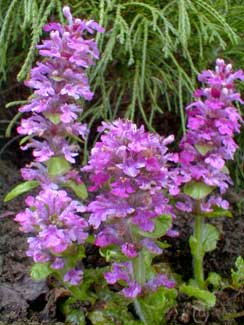
Pink Ajuga
or Bugleweed
"Frequently the wood are pink."
-Emily Dickinson
(1830-1886)
(1830-1886)
Ajuga reptans 'Pink Spire' (aka A. genevensis 'Pink Spires'), or Pink Spires Bugleweed, has longer than average spikes of bright pink flowers, six to eight inches tall, compared to the four or five inch spikes of 'Pink Beauty.'
The name Bugle or Bugleweed does not mean the musical instrument, which nothing of the plant resembles, but means 'wild ox' & has the same root as Bugloss which means "ox's tongue," perhaps in part because cattle ate just such rempant meadow flowers. But the classical botanist Linneus imaginatively named it Ajuga, meaning "has no ox's yoke," because the buds on the spike are not connected, just as a wild ox has no yoke, or is not married. The name reptans (frequently cataloged as repans) means "creeping" because of the plants rhizomic spreading habit.
In the Pacific Northwest ajuga likes full sun to partial shade, though further south it does best in partial shade. It can be grown deep under trees in difficult spots, including under walnut trees where it is unafflicted by the walnut's juglone which is toxic to so many perennials, although ajuga does not bloom as fabulously if it is too dark.
'Pink Spires' like other bugle cultivars can be drought hardy, but only looks superb when regularly watered. It also does well in a bog garden & can be useful for areas with poor drainage. It can potentially self-seed into new areas, but not as aggressively as it spreads in place by underground runners.
It has rapid spread by stolons & care should be taken in placement, lest it become aggressive. A clump can spread quite rapidly, even invasively, so other short groundcovers are apt to be displaced. It is no threat to larger perennials or shrubs, however, & makes a great groundcover around larger plants.
In our garden this mint-family perennial blooms as early as late March & is in full bloom for April & May. Old flower spikes should be sheered away to better show off the leaves for the rest of the year.
It is easily propagated by division autumn or spring, or any time of year since it bounces back reliably from most any shock. Division can be effected as often as every other year, or whenever it begins to look congested or is not as healthy-looking in the center; division completely renews it.
Some people dislike ajuga because if it can spread into a lawn whereit can be difficult to get back out. It's truly one of the finest groundcovers, however, nearly maintenance-free & always attractive, with sturdy enough rhizomes that it is useful for controlling slope erosion. But for anyone who is just dead-set against planting anything that spreads so easily, there is a bigger-flowering option: A. pyramidalis, which despite its greater size looks very similar, except that it remains clumping-in-place, having no rhizomes.
Continue to:
Ajuga reptens 'Burgundy Glow'
Ajuga reptens 'Burgundy Glow'